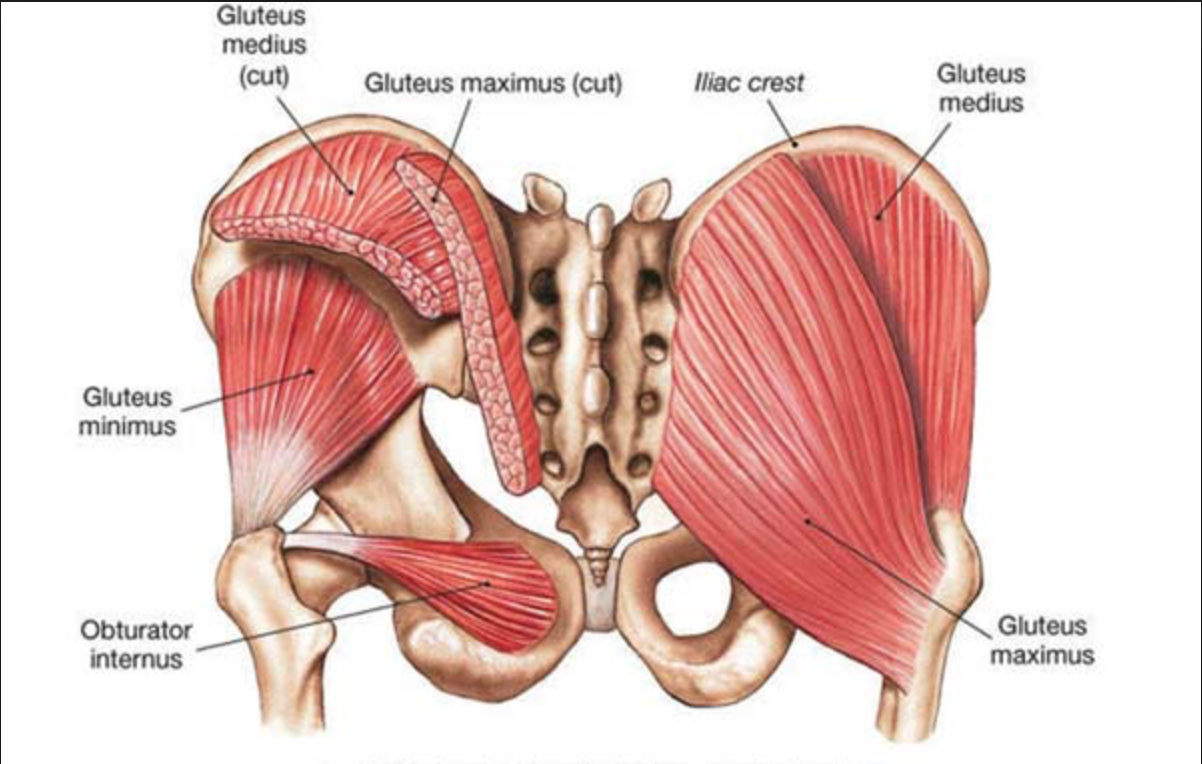Ahhhh, the gluteus medius. AKA: the glute med!
Unless you are a runner, ballet dancer or a yogi, you probably have never heard of this muscle before.
It is one of the three gluteus muscles, along with the gluteus maximus and minimus and originates on the outer surface of the ilium (pelvis) just below the iliac crest and converges as a large flattened tendon onto the lateral greater trochanter of the femur (thigh bone).
AND WHAT IS the FUNCTION of the glute med?
The main function of the glute med is abduction of the hip. Abduction is when you move the leg away from the center of the body. Is also responsible for external rotation of the hip when the hip is extended and internal rotation of the hip when it is flexed…more accurately; it prevents external rotation when flexed.
But, the most important job of the glute med is stabilization of the pelvis. Activation of the muscle prevents dropping of the pelvis when standing on one leg. When the glute med is injured or weak, it allows the opposite hip to drop when weight bearing on one leg such as when walking or running.
It also helps your bigger gluteus maximus muscle flex and extend your leg. Having strong glutes is important because we use our glutes in everyday life when you push off the ground while walking, running, or stepping.
WHAT HAPPENS IF the gluteus med IS DISFUNCTIONAL?
When the gluteus medius does not function well, there are implications down to the lower limbs.
A person with weak gluteus medius may exhibit the Trendenlenburg sign during walking - The pelvis will drop on the opposte side. If this situation is not addressed, there will be risks of structural overload to the lumbar spine, sacroiliac joint , hip and knee – and may cause excessive wear and tear at these joints.
A weak gluteus medius can lead to the inward collapse on the knee, placing more pressure on your knee
The figure above shows three different trigger points in the muscle and the pain referral pattern for each. All three of these referral patterns present on a regular basis. Patients come in with low back pain and are surprised to learn it’s not their low back at all, but their glutes. The glute med is constantly firing when we are upright so it makes sense that the muscle is overworked.
INJURIES INFLUENCED BY A POORLY FUNCTIONING OR OVERLOADED GLUTEUS MEDIUS
The injuries include, but are not limited to:
Gluteal Tendinopathy
Gluteal Muscle Strain or Tear
Patellofemoral Joint Pain Syndrome / Anterior Knee Pain
ITB Friction Syndrome
Achilles Tendinopathy
Hamstring Injuries
Hip and Knee Osteoarthritis
Piriformis Syndrome
Trochanteric Bursitis
HOW DO I TRAIN MY GLUTEUS MEDIUS?
Gluteus Medius is most active when performing isolated single-limb exercises.
Research shows that integration of trunk and lumbar stability exercises can further reduce loading onto and requirements of the Gluteus Medius.
We’d recommend the following exercises.
Clams
Bridges with theraband
Ball at the wall squat
Crab walk
Monster walk
SO, AFTER ALL, DO I NEED A BUTT MASSAGE?!
Fun fact, the Gluteus muscles are the largest muscle in the body. If that area gets skipped over your therapist is missing a huge portion of the body. Now you might be totally cool with that, but if you have back pain, knee pain, hip pain or even leg pain? Your glutes may be the reason for it.
Massage in this area will be important to everyone, athletes, arm chair athletes, desk workers, people that stand all day...you get the picture. Muscles all have origin and insertion point that pull and shorten when put under any stress.
If you are a bit shy, always let the therapists know any of your reservations. Glutes can easily be worked on top of the sheet or through clothing. Or the therapist will always drop modestly with a sheet working one side at a time.
So, at your next massage, remember to get the glutes worked on! Your back, legs, hips & knees will thanks you!




